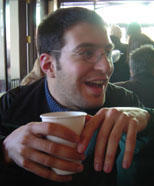Transcriptional Activation
Yes the daily transcript has an entry on TRANSCRIPTION.
Yesterday I attended a talk given by Robert Tjian from UC Berkeley (HHMI profile). So what is new in the world of transcription?
Well he gave a nice intro. He explained how his lab first thought about the problem, then conducted "promoter bashing" experiments to identify DNA regions important for activating flanking gene sequences. Then he presented the current model. Promoter and enhancer DNA regions that flank the gene, bind proteins (i.e. transcription factors or TFs) that interact with a big complex ... TFIID. This complex includes the TATA binding protein (TBP) and Tata binding factors (TAFs). Under the influence of TFs, TFIID unzips the DNA and recruits RNA Polymerase II, the enzyme that copies the gene's DNA sequence into mRNA (this copying process is called "TRANSCRIPTION").

So the big question is how is transcription spatially and temporally regulated? In other words how do different cells turn on different genes? And how does the same cell turn on different genes at different times (such as during development)?
The answer? As far as I can tell confusion. We know that different TFs and different TAFs are expressed in different cells, we know that the whole thing is complex ... but beyond these simple statements, Prof Tjian could not offer further insight. I left the talk with "a bad taste in my mouth" (sorry for the cliche).
Something needs to happen in this field for it to make some serious progress. Perhaps the idea of picking model genes or understanding how one gene is differentially activated in different cells at different times, is not the best approach. Another plan of attack is needed.
Perhaps there is some hope - a student who rotated in the lab this summer, joined another lab who's goal is to coat microarrays with small DNA fragments and probe these arrays with labeled transcription factors. In otherwords BIG BIOLOGY. Now I'm no fan of big biology, but maybe it can be used to understand how these various components work together to generate temporal and spatial differential expression of genes.
Yesterday I attended a talk given by Robert Tjian from UC Berkeley (HHMI profile). So what is new in the world of transcription?
Well he gave a nice intro. He explained how his lab first thought about the problem, then conducted "promoter bashing" experiments to identify DNA regions important for activating flanking gene sequences. Then he presented the current model. Promoter and enhancer DNA regions that flank the gene, bind proteins (i.e. transcription factors or TFs) that interact with a big complex ... TFIID. This complex includes the TATA binding protein (TBP) and Tata binding factors (TAFs). Under the influence of TFs, TFIID unzips the DNA and recruits RNA Polymerase II, the enzyme that copies the gene's DNA sequence into mRNA (this copying process is called "TRANSCRIPTION").

So the big question is how is transcription spatially and temporally regulated? In other words how do different cells turn on different genes? And how does the same cell turn on different genes at different times (such as during development)?
The answer? As far as I can tell confusion. We know that different TFs and different TAFs are expressed in different cells, we know that the whole thing is complex ... but beyond these simple statements, Prof Tjian could not offer further insight. I left the talk with "a bad taste in my mouth" (sorry for the cliche).
Something needs to happen in this field for it to make some serious progress. Perhaps the idea of picking model genes or understanding how one gene is differentially activated in different cells at different times, is not the best approach. Another plan of attack is needed.
Perhaps there is some hope - a student who rotated in the lab this summer, joined another lab who's goal is to coat microarrays with small DNA fragments and probe these arrays with labeled transcription factors. In otherwords BIG BIOLOGY. Now I'm no fan of big biology, but maybe it can be used to understand how these various components work together to generate temporal and spatial differential expression of genes.


<< Home